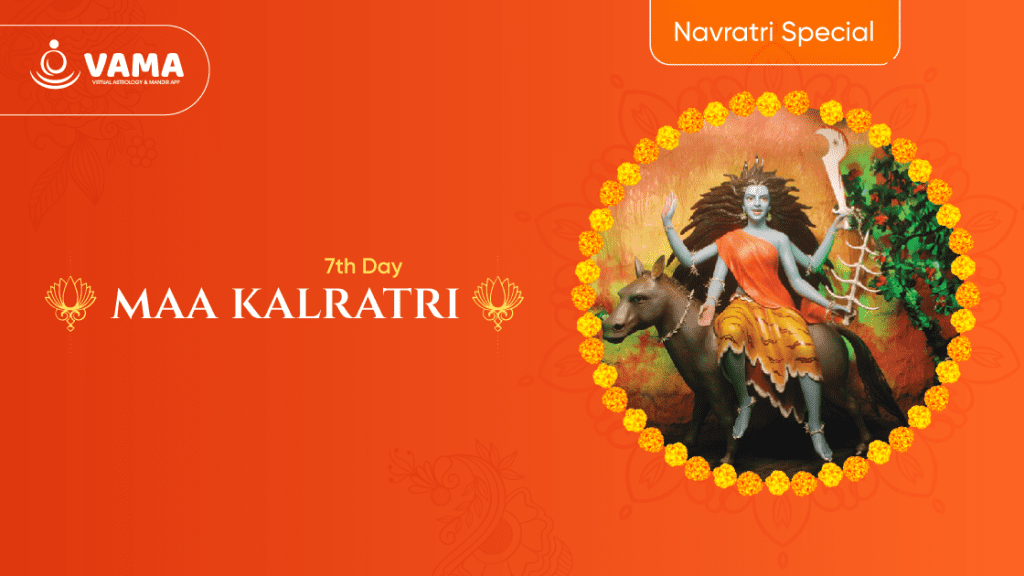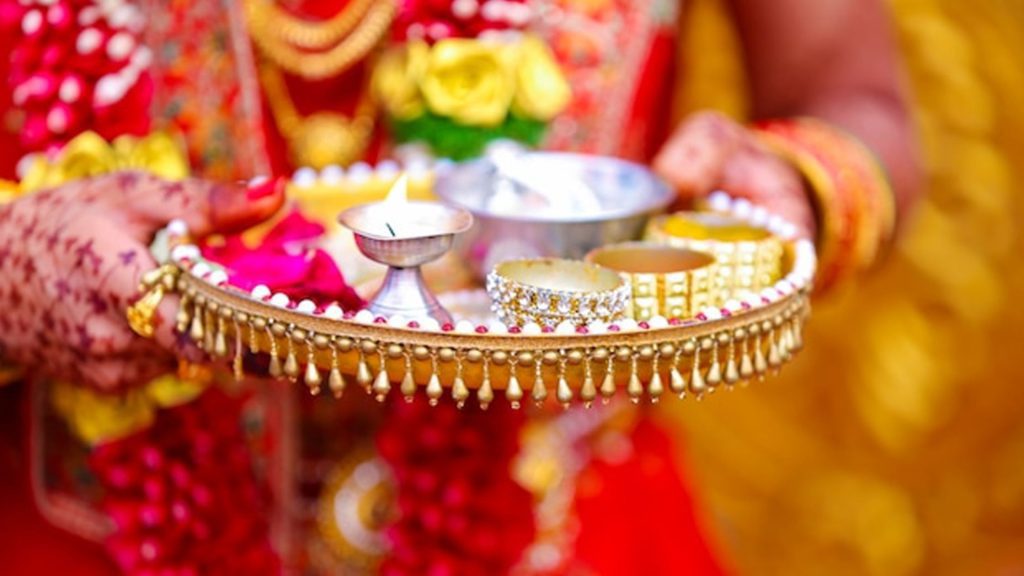Navratri 2023 Day 7: Who is Maa Kalratri? Know all about day 7 puja vidhi, significance, samagri, and more
Today, as we journey into the seventh day of Navratri, we encounter Maa Kalratri, the fierce and unapologetic goddess who represents the shadows, and in doing so, brings forth enlightenment.

Navratri 2023 Day 7: Have you ever pondered the transformative power of darkness, or the strength that comes from facing your deepest fears? Indeed, her worship encourages individuals to confront their fears and challenges with determination and resilience.
Today, as we journey into the seventh day of Navratri, we encounter Maa Kalratri, the fierce and unapologetic goddess who represents the shadows, and in doing so, brings forth enlightenment.
Join us on a captivating exploration of the significance of the seventh day of Navratri, where we’ll delve into the rituals that connect us with Maa Kalratri’s potent energy, and unveil the profound symbolism that defines this day’s celebration. From the colour of the day to the mystic chants, let’s step into the realm of divine knowledge on Navratri’s seventh day, where fierceness, strength, and inner illumination reign supreme.

The Mystic Essence of Maa Kalratri
On the seventh day of Navratri, our focus is drawn to Maa Kalratri, a fierce and formidable form of Goddess Durga. She is mostly portrayed riding a donkey and carrying a sharp sword and a deadly iron hook. Maa Kalratri is often depicted with a dark complexion, untidy hair, a fearless posture, and a fiery expression. Her name ‘Kalratri’ translates to ‘Black Night,’ symbolising the darkness that precedes the dawn of knowledge and enlightenment.
The Significance of Day 7: Transcending Darkness
As we honour Maa Kalratri on this day, we seek her blessings to transcend our fears, doubts, and ignorance. She is believed to destroy ignorance, darkness, and obstacles on the spiritual path. Her worship is considered especially powerful in removing the most formidable of obstacles. A representation of the fearless pursuit of truth, even in the face of darkness and adversity, Maa Kalratri is a reminder that sometimes, it is in confronting our deepest fears that we discover our true strength.
The Colour associated with Maa Kalratri: Dark Blue
In the vibrant tapestry of Navratri, each day is adorned with a unique colour, and on the seventh day, dark blue takes centre stage. This hue represents the profound mysteries of the cosmos and the deep reservoir of knowledge that Maa Kalratri holds. Wearing dark blue attire on this day is a way to connect with her transformative energy and seek her blessings for inner illumination and be guided towards spiritual enlightenment and self-realisation.
Rituals and Traditions
Devotees celebrate this day with reverence and awe. The day typically begins with a special puja (worship) dedicated to Maa Kalratri. Offerings of flowers, incense, and sacred scriptures are made to the goddess. Devotees also recite prayers and mantras to invoke her wisdom and fearlessness.

Puja Vidhi
1. Preparation:
- On the seventh day of the puja, start by cleansing yourself both physically and spiritually. Take a bath to purify your body and wear clean, traditional attire. This step symbolises your readiness to engage in a sacred act of worship.
- Find a quiet and clean space in your home, which will serve as your puja altar or sacred area.
- Arrange the necessary items for the puja, including:
- A picture or idol of the deity you are worshipping. The choice of deity depends on the purpose of your puja or your personal devotion.
- Fresh flowers, preferably marigolds and roses, which are considered auspicious.
- Incense sticks or agarbattis for creating a fragrant atmosphere during the puja.
- A diya (oil lamp) with a cotton wick and oil. The diya represents the divine light dispelling darkness.
- Fruits, sweets (such as laddoos or modaks), and other traditional offerings like coconut, betel leaves, and betel nuts.
2. Invocation:
- Start the puja by invoking the presence of the divine. This is done through the recitation of mantras or prayers. The specific mantras can vary based on the deity you are worshipping. For example, if you’re worshipping Lord Ganesha, you might chant “Om Ganeshaya Namaha.” Similarly, you may chant the mantra for Maa Kalratri mentioned below.
3. Abhishek:
- Perform abhishek, which involves bathing the deity’s idol with Panchamrit (mixture of milk, curd, ghee, honey, and sugar), water, and then clean water. Chant relevant mantras during this process.
4. Offerings:
- Make symbolic offerings to the deity to demonstrate your devotion. You offer these items to the divine as a sign of your reverence and dedication.
- Place the fresh flowers, light the incense, and kindle the diya.
5. Prayers and Chanting:
- Recite relevant prayers, stotras (hymns), or bhajans (devotional songs) dedicated to the chosen deity. The prayers can express your love, gratitude, and desires.
6. Aarti:
- Perform aarti, a ritual where you circulate the lit diya in front of the deity. While doing this, you sing or recite an aarti song that praises the deity’s greatness.
7. Meditation:
- Spend some time meditating. Meditation allows you to focus on your intentions, seek blessings, and establish a deeper connection with the divine. You can meditate on the form of the deity or simply reflect on the divine qualities.
8. Distribution of Prasad:
- Distribute the prasad (blessed offerings) to your family members or other devotees present. Sharing prasad is considered a way of spreading the divine blessings.
9. Closing and Thanksgiving:
- Conclude the puja by asking for the deity’s blessings and guidance. This is the time to state your specific wishes or desires that you seek from the deity.
- Bow your head in humility and thanksgiving, acknowledging the divine presence. Express your gratitude to the deity for their blessings and protection. You can offer your heartfelt thanks through prayer.
The Mantra of Maa Kalratri
One of the powerful mantras associated with Maa Kalratri is:
“ॐ देवी कालरात्र्यै नमः” (Om Devi Kalratryai Namah)
This mantra is chanted with devotion to invoke the transformative and fearless energy of Maa Kalratri.
Frequency
There is no strict rule regarding the number of times you should chant the mantra. Some people may choose to chant it a specific number of times, such as 108 or 1008, while others may chant it continuously during their worship and meditation.The most important aspect is the intent and devotion with which you chant the mantra.
Transcending Fear and Embracing Wisdom
The seventh day of Navratri is a poignant reminder that wisdom and enlightenment often result from confronting our deepest fears and addressing the inner darkness. It’s a time for self-reflection on our ability to transcend ignorance and uncover the inner light that shines within us.
Maa Kalratri is a gentle reminder that just as night is followed by day, difficulties are temporary, and one can emerge stronger and wiser from them. While we immerse ourselves in the profound blue aura of this day, let us not only seek the blessings of Maa Kalratri, but also embrace the fearless pursuit of knowledge, patience, and inner illumination in our personal journeys. Just as she bravely navigates through darkness, may we too fearlessly seek and pursue truth, wisdom, and enlightenment.
As we bid adieu to the seventh day of Navratri, may the transformative power of Maa Kalratri persist in guiding us, empowering us to confront our fears and emerge with a deeper understanding of ourselves and the world around us.
“In her divine presence, we discover the courage to confront shadows and uncover the brilliance of inner enlightenment.”





